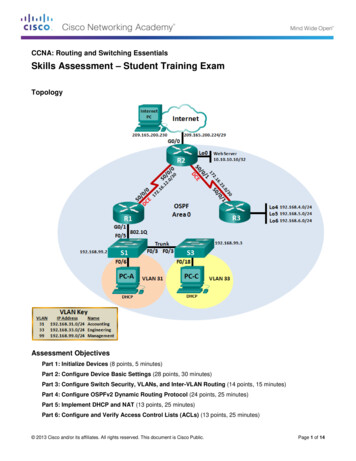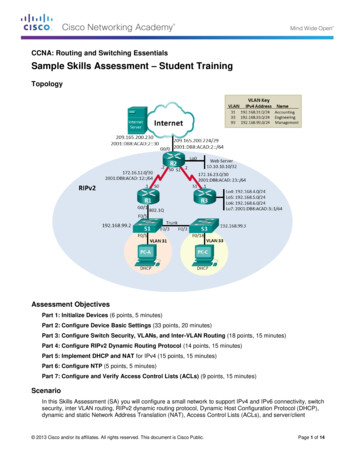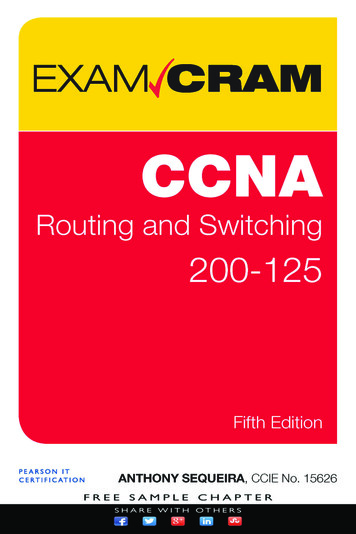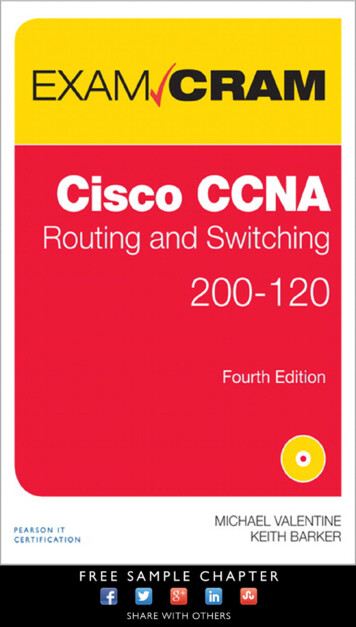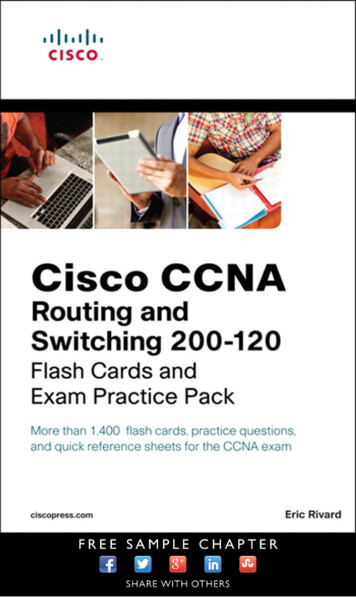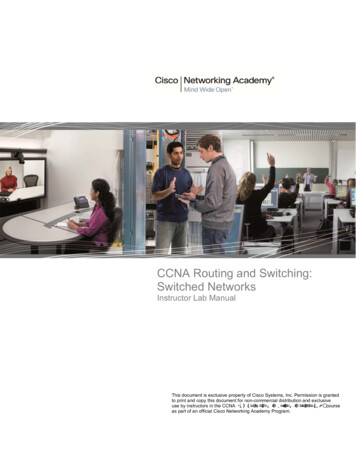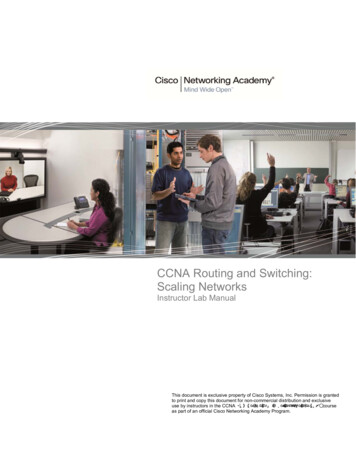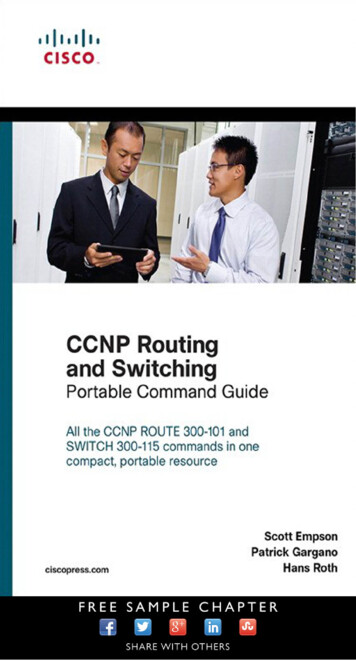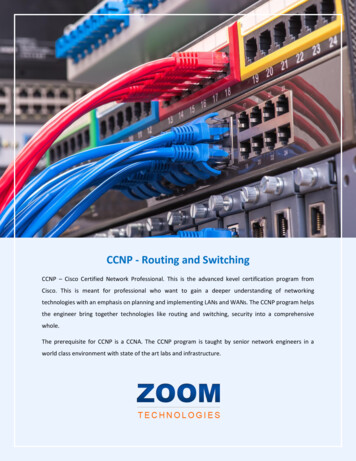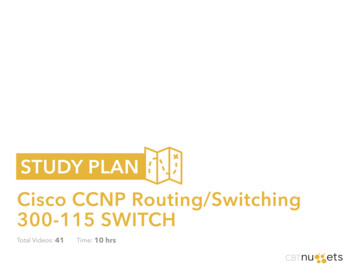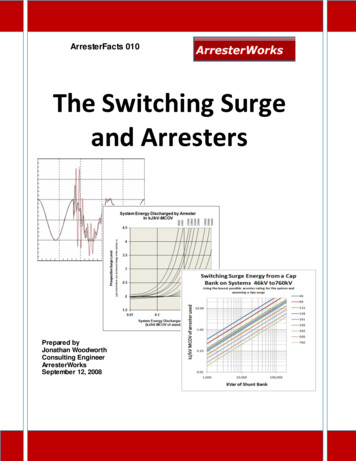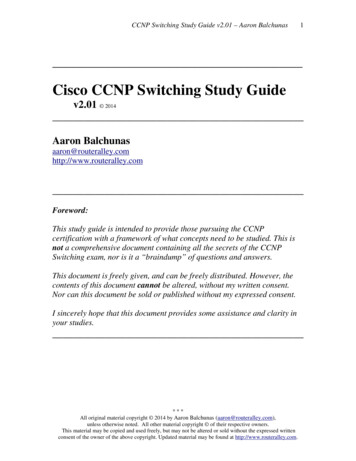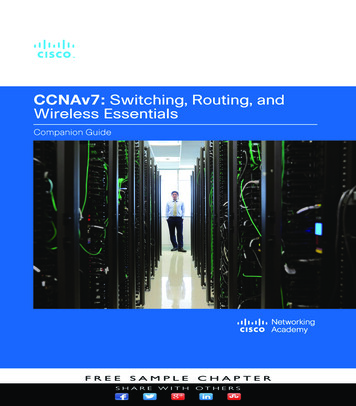
Transcription
Switching, Routing, andWireless EssentialsCompanion Guide (CCNAv7)Cisco PressHoboken, New Jersey
iiSwitching, Routing, and Wireless Essentials Companion Guide (CCNAv7)Switching, Routing, andWireless EssentialsCompanion Guide (CCNAv7)Copyright 2020 Cisco Systems, Inc.Published by:Cisco PressHoboken, New JerseyAll rights reserved. No part of this book may be reproduced or transmitted inany form or by any means, electronic or mechanical, including photocopying,recording, or by any information storage and retrieval system, without writtenpermission from the publisher, except for the inclusion of brief quotations in areview.ScoutAutomatedPrintCodeEditor-in-ChiefMark TaubAlliances Manager,Cisco PressArezou GolDirector, ITP ProductManagementBrett BartowSenior EditorJames ManlyManaging EditorSandra SchroederDevelopment EditorMarianne BartowLibrary of Congress Control Number: 2020936826Senior Project EditorTonya SimpsonISBN-13: 978-0-13-672935-8ISBN-10: 0-13-672935-5Copy EditorBarbara HachaWarning and DisclaimerTechnical EditorRick GrazianiThis book is designed to provide information about the Cisco NetworkingAcademy Switching, Routing, and Wireless Essentials course. Every effort hasbeen made to make this book as complete and as accurate as possible, but nowarranty or fitness is implied.Editorial AssistantCindy TeetersThe information is provided on an “as is” basis. The authors, Cisco Press, andCisco Systems, Inc. shall have neither liability nor responsibility to any personor entity with respect to any loss or damages arising from the informationcontained in this book or from the use of the discs or programs that mayaccompany it.CompositioncodeMantraThe opinions expressed in this book belong to the author and are notnecessarily those of Cisco Systems, Inc.Cover DesignerChuti PrasertsithIndexerCheryl Ann LenserProofreaderAbigail Manheim
iiiTrademark AcknowledgmentsAll terms mentioned in this book that are known to be trademarks or service marks have beenappropriately capitalized. Cisco Press or Cisco Systems, Inc., cannot attest to the accuracy of thisinformation. Use of a term in this book should not be regarded as affecting the validity of any trademarkor service mark.Feedback InformationAt Cisco Press, our goal is to create in-depth technical books of the highest quality and value. Eachbook is crafted with care and precision, undergoing rigorous development that involves the uniqueexpertise of members from the professional technical community.Readers’ feedback is a natural continuation of this process. If you have any comments regarding how wecould improve the quality of this book, or otherwise alter it to better suit your needs, you can contactus through email at feedback@ciscopress.com. Please make sure to include the book title and ISBN inyour message.We greatly appreciate your assistance.Americas HeadquartersCisco Systems, Inc.San Jose, CAAsia Pacific HeadquartersCisco Systems (USA) Pte. Ltd.SingaporeEurope HeadquartersCisco Systems International BV Amsterdam,The NetherlandsCisco has more than 200 offices worldwide. Addresses, phone numbers, and fax numbers are listed on the Cisco Website at www.cisco.com/go/offices.Cisco and the Cisco logo are trademarks or registered trademarks of Cisco and/or its affiliates in the U.S. and other countries. To view a list of Cisco trademarks,go to this URL: www.cisco.com/go/trademarks. Third party trademarks mentioned are the property of their respective owners. The use of the word partner doesnot imply a partnership relationship between Cisco and any other company. (1110R)
iv Switching, Routing, and Wireless Essentials Companion Guide (CCNAv7)About the Contributing AuthorsBob Vachon is a professor at Cambrian College (Sudbury, Ontario, Canada) andAlgonquin College (Ottawa, Ontario, Canada). He has more than 30 years of teachingexperience in computer networking and information technology. He has also collaborated on many Cisco Networking Academy courses, including CCNA, CCNA Security, CCNP, and Cybersecurity as team lead, lead author, and subject matter expert.Bob enjoys family, friends, and being outdoors playing guitar by a campfire.Allan Johnson entered the academic world in 1999 after 10 years as a businessowner/operator to dedicate his efforts to his passion for teaching. He holds both anMBA and an M.Ed. in training and development. He taught CCNA courses at thehigh school level for seven years and has taught both CCNA and CCNP courses atDel Mar College in Corpus Christi, Texas. In 2003, Allan began to commit much ofhis time and energy to the CCNA Instructional Support Team providing services toNetworking Academy instructors worldwide and creating training materials. He nowworks full time for Cisco Networking Academy as Curriculum Lead.
vContents at a GlanceIntroduction xxviiChapter 1Basic Device Configuration 1Chapter 2Switching Concepts 45Chapter 3VLANsChapter 4Inter-VLAN RoutingChapter 5STP Concepts 137Chapter 6EtherChannelChapter 7DHCPv4Chapter 8SLAAC and DHCPv6 223Chapter 9FHRP Concepts 261Chapter 10LAN Security Concepts 275Chapter 11Switch Security ConfigurationChapter 12WLAN Concepts 347Chapter 13WLAN Configuration 397Chapter 14Routing Concepts 445Chapter 15IP Static RoutingChapter 16Troubleshoot Static and Default Routes 531Appendix AAnswers to the “Check Your Understanding” Questions 5455997175199Glossary 561Index 587313495
viSwitching, Routing, and Wireless Essentials Companion Guide (CCNAv7)Reader Services
viiContentsIntroductionChapter 1xxviiBasic Device ConfigurationObjectives11Key Terms 1Introduction (1.0) 2Configure a Switch with Initial Settings (1.1) 2Switch Boot Sequence (1.1.1) 2The boot system Command (1.1.2) 3Switch LED Indicators (1.1.3)3Recovering from a System Crash (1.1.4) 6Switch Management Access (1.1.5)8Switch SVI Configuration Example (1.1.6)Configure Switch Ports (1.2)811Duplex Communication (1.2.1)11Configure Switch Ports at the Physical Layer (1.2.2)Auto-MDIX (1.2.3)1213Switch Verification Commands (1.2.4) 14Verify Switch Port Configuration (1.2.5) 14Network Access Layer Issues (1.2.6)15Interface Input and Output Errors (1.2.7) 17Troubleshooting Network Access Layer Issues (1.2.8) 18Secure Remote Access (1.3)Telnet Operation (1.3.1)2020SSH Operation (1.3.2) 20Verify the Switch Supports SSH (1.3.3) 22Configure SSH (1.3.4) 22Verify SSH Is Operational (1.3.5)Basic Router Configuration (1.4)2425Configure Basic Router Settings (1.4.1)Dual Stack Topology (1.4.3) 27Configure Router Interfaces (1.4.4)IPv4 Loopback Interfaces (1.4.6)272826
viiiSwitching, Routing, and Wireless Essentials Companion Guide (CCNAv7)Verify Directly Connected Networks (1.5)29Interface Verification Commands (1.5.1) 30Verify Interface Status (1.5.2) 30Verify IPv6 Link Local and Multicast Addresses (1.5.3) 31Verify Interface Configuration (1.5.4) 32Verify Routes (1.5.5) 32Filter Show Command Output (1.5.6) 34The section Filter 34The include Filter 34The exclude Filter 35The begin Filter 35Command History Feature (1.5.8) 36Summary (1.6) 38Configure a Switch with Initial Settings38Configure Switch Ports 38Secure Remote Access 38Basic Router Configuration39Verify Directly Connected Networks 39Practice 40Check Your Understanding Questions 41Chapter 2Switching Concepts 45Objectives 45Key Terms45Introduction (2.0) 46Frame Forwarding (2.1) 46Switching in Networking (2.1.1)46The Switch MAC Address Table (2.1.2)47The Switch Learn and Forward Method (2.1.3)Switching Forwarding Methods (2.1.5) 48Store-and-Forward Switching (2.1.6)Cut-Through Switching (2.1.7)4949Collision and Broadcast Domains (2.2)51Collision Domains (2.2.1) 51Broadcast Domains (2.2.2) 52Alleviate Network Congestion (2.2.3) 5348
ixSummary (2.3) 55Frame Forwarding55Switching Domains 55Check Your Understanding QuestionsChapter 3VLANs5659Objectives 59Key Terms59Introduction (3.0) 60Overview of VLANs (3.1) 60VLAN Definitions (3.1.1)60Benefits of a VLAN Design (3.1.2) 61Types of VLANs (3.1.3) 63Default VLAN 63Data VLAN 64Native VLAN 64Management VLAN 64Voice VLAN 65VLANs in a Multi-Switched Environment (3.2) 66Defining VLAN Trunks (3.2.1)66Network Without VLANs (3.2.2) 67Network with VLANs (3.2.3) 68VLAN Identification with a Tag (3.2.4) 69VLAN Tag Field Details 69Native VLANs and 802.1Q Tagging (3.2.5) 70Tagged Frames on the Native VLAN 70Untagged Frames on the Native VLAN 70Voice VLAN Tagging (3.2.6) 71Voice VLAN Verification Example (3.2.7) 72VLAN Configuration (3.3) 73VLAN Ranges on Catalyst Switches (3.3.1) 73Normal Range VLANs 74Extended Range VLANs 74VLAN Creation Commands (3.3.2) 75VLAN Creation Example (3.3.3) 75VLAN Port Assignment Commands (3.3.4) 76VLAN Port Assignment Example (3.3.5) 77Data and Voice VLANs (3.3.6) 78
xSwitching, Routing, and Wireless Essentials Companion Guide (CCNAv7)Data and Voice VLAN Example (3.3.7)Verify VLAN Information (3.3.8)7879Change VLAN Port Membership (3.3.9)81Delete VLANs (3.3.10) 82VLAN Trunks (3.4)83Trunk Configuration Commands (3.4.1)Trunk Configuration Example (3.4.2)Verify Trunk Configuration (3.4.3)838385Reset the Trunk to the Default State (3.4.4)Dynamic Trunking Protocol (3.5)Introduction to DTP (3.5.1)868788Negotiated Interface Modes (3.5.2) 89Results of a DTP Configuration (3.5.3)89Verify DTP Mode (3.5.4) 90Summary (3.6) 92Overview of VLANs92VLANs in a Multi-Switched Environment92VLAN Configuration 92VLAN Trunks 93Dynamic Trunking Protocol 93Practice 93Check Your Understanding Questions 94Chapter 4Inter-VLAN Routing97Objectives 97Key Terms97Introduction (4.0) 98Inter-VLAN Routing Operation (4.1)98What Is Inter-VLAN Routing? (4.1.1)98Legacy Inter-VLAN Routing (4.1.2) 98Router-on-a-Stick Inter-VLAN Routing (4.1.3) 100Inter-VLAN Routing on a Layer 3 Switch (4.1.4) 102
xiRouter-on-a-Stick Inter-VLAN Routing (4.2) 103Router-on-a-Stick Scenario (4.2.1) 103S1 VLAN and Trunking Configuration (4.2.2) 105S2 VLAN and Trunking Configuration (4.2.3) 106R1 Subinterface Configuration (4.2.4) 107Verify Connectivity Between PC1 and PC2 (4.2.5) 108Router-on-a-Stick Inter-VLAN Routing Verification (4.2.6)Inter-VLAN Routing using Layer 3 Switches (4.3)110112Layer 3 Switch Inter-VLAN Routing (4.3.1) 112Layer 3 Switch Scenario (4.3.2)113Layer 3 Switch Configuration (4.3.3)114Layer 3 Switch Inter-VLAN Routing Verification (4.3.4) 115Routing on a Layer 3 Switch (4.3.5)116Routing Scenario on a Layer 3 Switch (4.3.6) 116Routing Configuration on a Layer 3 Switch (4.3.7)Troubleshoot Inter-VLAN Routing (4.4)117119Common Inter-VLAN Issues (4.4.1) 119Troubleshoot Inter-VLAN Routing Scenario (4.4.2) 120Missing VLANs (4.4.3) 121Switch Trunk Port Issues (4.4.4) 124Switch Access Port Issues (4.4.5) 125Router Configuration Issues (4.4.6) 127Summary (4.5) 130Inter-VLAN Routing Operation130Router-on-a-Stick Inter-VLAN Routing130Inter-VLAN Routing Using Layer 3 Switches 130Troubleshoot Inter-VLAN Routing131Practice 132Check Your Understanding Questions 132Chapter 5STP Concepts 137Objectives 137Key Terms137
xiiSwitching, Routing, and Wireless Essentials Companion Guide (CCNAv7)Introduction (5.0) 139Purpose of STP (5.1) 139Redundancy in Layer 2 Switched Networks (5.1.1) 139Spanning Tree Protocol (5.1.2) 140STP Recalculation (5.1.3)141Issues with Redundant Switch Links (5.1.4) 141Layer 2 Loops (5.1.5) 142Broadcast Storm (5.1.6) 143The Spanning Tree Algorithm (5.1.7)STP Operations (5.2)145148Steps to a Loop-Free Topology (5.2.1) 148Bridge Priority 149Extended System ID 149MAC address 1501. Elect the Root Bridge (5.2.2) 150Impact of Default BIDs (5.2.3) 151Determine the Root Path Cost (5.2.4) 1522. Elect the Root Ports (5.2.5) 1523. Elect Designated Ports (5.2.6) 1534. Elect Alternate (Blocked) Ports (5.2.7) 156Elect a Root Port from Multiple Equal-Cost Paths (5.2.8)1. Lowest Sender BID 1572. Lowest Sender Port Priority 1573. Lowest Sender Port ID 158STP Timers and Port States (5.2.9) 158Operational Details of Each Port State (5.2.10)Per-VLAN Spanning Tree (5.2.11) 160Evolution of STP (5.3)161Different Versions of STP (5.3.1) 161RSTP Concepts (5.3.2)162RSTP Port States and Port Roles (5.3.3) 163STP and RSTP Port States 163PortFast and BPDU Guard (5.3.4) 165Alternatives to STP (5.3.5) 166160156
xiiiSummary (5.4) 169Purpose of STP 169STP Operations 169Evolution of STP 170Practice 171Check Your Understanding Questions 171Chapter 6EtherChannel175Objectives 175Key Terms175Introduction (6.0) 176EtherChannel Operation (6.1) 176Link Aggregation (6.1.1) 176EtherChannel (6.1.2)177Advantages of EtherChannel (6.1.3) 177Implementation Restrictions (6.1.4)178AutoNegotiation Protocols (6.1.5) 179PAgP Operation (6.1.6) 180PAgP Mode Settings Example (6.1.7) 181LACP Operation (6.1.8) 181LACP Mode Settings Example (6.1.9) 182Configure EtherChannel (6.2)183Configuration Guidelines (6.2.1)183LACP Configuration Example (6.2.2) 185Verify and Troubleshoot EtherChannel (6.3) 186Verify EtherChannel (6.3.1) 186Common Issues with EtherChannel Configurations (6.3.2)Troubleshoot EtherChannel Example (6.3.3) 189Summary (6.4) 193EtherChannel Operation 193Configure EtherChannel 193Verify and Troubleshoot EtherChannelPractice 195Check Your Understanding Questions 195194188
xivSwitching, Routing, and Wireless Essentials Companion Guide (CCNAv7)Chapter 7DHCPv4199Objectives 199Key Terms199Introduction (7.0) 200DHCPv4 Concepts (7.1)200DHCPv4 Server and Client (7.1.1) 200DHCPv4 Operation (7.1.2)201Steps to Obtain a Lease (7.1.3) 201Steps to Renew a Lease (7.1.4) 203Configure a Cisco IOS DHCPv4 Server (7.2) 204Cisco IOS DHCPv4 Server (7.2.1) 204Steps to Configure a Cisco IOS DHCPv4 Server (7.2.2)Configuration Example (7.2.3)205206DHCPv4 Verification Commands (7.2.4) 207Verify DHCPv4 is Operational (7.2.5) 207Verify the DHCPv4 Configuration 207Verify DHCPv4 Bindings 208Verify DHCPv4 Statistics 208Verify DHCPv4 Client Received IPv4 AddressingDisable the Cisco IOS DHCPv4 Server (7.2.7) 210DHCPv4 Relay (7.2.8) 210The ipconfig /release Command 211The ipconfig /renew Command 211The ip helper-address Command
Summary (4.5) 130 Inter-VLAN Routing Operation 130 Router-on-a-Stick Inter-VLAN Routing 130 Inter-VLAN Routing Using Layer 3 Switches 130 Troubleshoot Inter-VLAN Routing 131 Practice 132 Check Your Understanding Questions 132 Chapter 5 STP Concepts 137 Objectives 137 Key Terms 137
